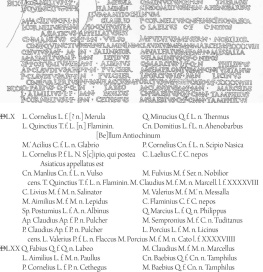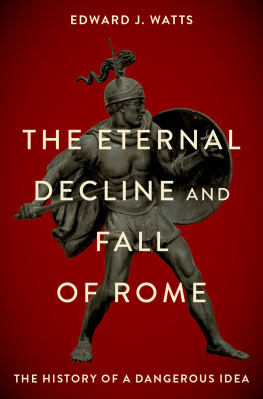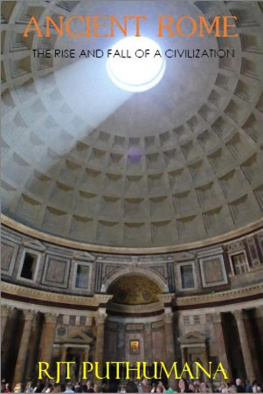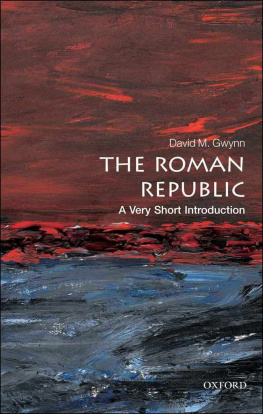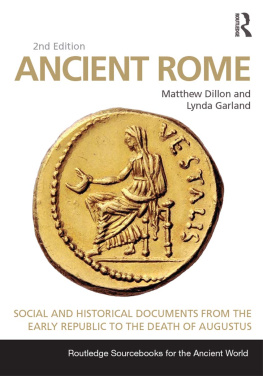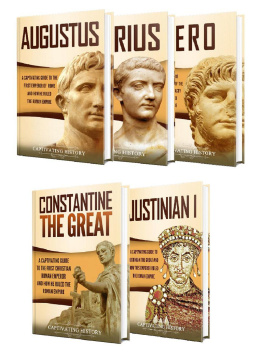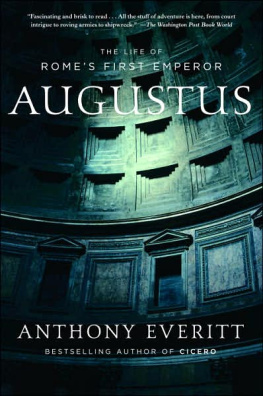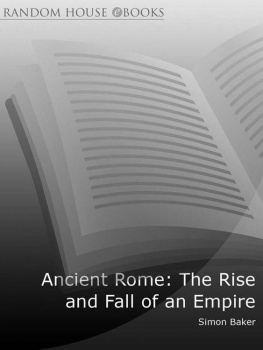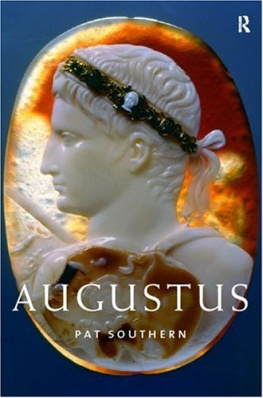THE
ROMAN REVOLUTION
THE
ROMAN REVOLUTION
BY
RONALD SYME


Great Clarendon Street, Oxford 0x2 6DP
Oxford University Press is a department of the University of Oxford.
It furthers the Universitys objective of excellence in research, scholarship,
and education by publishing worldwide in
Oxford New York
Athens Auckland Bangkok Bogot Buenos Aires Calcutta
CapeTown Chennai Dares Salaam Delhi Florence Hong Kong Istanbul
Karachi Kuala Lumpur Madrid Melbourne Mexico City Mumbai
Nairobi Paris So Paulo Singapore Taipei Tokyo Toronto Warsaw
with associated companies in Berlin Ibadan
Oxford is a registered trade mark of Oxford University Press
in the UK and in certain other countries
Published in the United States by
Oxford University Press Inc., New York
Oxford University Press 1939
First published by the Clarendon Press 1939
Reprinted from corrected sheets of the First Edition
1952, 1956
First issued as an Oxford University Press paperback 1960
All rights reserved. No part of this publication may be reproduced,
stored in a retrieval system, or transmitted, in any form or by any means,
without the prior permission in writing of Oxford University Press,
or as expressly permitted by law, or under terms agreed with the appropriate
reprographics rights organization. Enquiries concerning reproduction
outside the scope of the above should be sent to the Rights Department,
Oxford University Press, at the address above
You must not circulate this book in any other binding or cover
and you must impose this same condition on any acquirer
ISBN 0-19-881001-6
23 25 27 29 30 28 26 24 22
Printed in Great Britain by
Cox & Wyman Ltd
Reading, Berkshire
PARENTIBVS OPTIMIS PATRIAEQVE
PREFACE
THE subject of this book is the transformation of state and society at Rome between 60 B.C. and A.D. 14. It is composed round a central narrative that records the rise to power of Augustus and the establishment of his rule, embracing the years 4423 B.C. (chapters viixxiii). The period witnessed a violent transference of power and of property; and the Principate of Augustus should be regarded as the consolidation of the revolutionary process. Emphasis is laid, however, not upon the personality and acts of Augustus, but upon his adherents and partisans. The composition of the oligarchy of government therefore emerges as the dominant theme of political history, as the binding link between the Republic and the Empire: it is something real and tangible, whatever may be the name or theory of the constitution.
To that end, the space (and significance) allotted to the biographies of Pompeius, Caesar and Augustus, to warfare, to provincial affairs and to constitutional history has been severely restricted. Instead, the noble houses of Rome and the principal allies of the various political leaders enter into their own at last. The method has to be selective: exhaustive detail cannot be provided about every family or individual. Even so, the subject almost baffles exposition. The reader who is repelled by a close concatenation of proper names must pass rapidly over certain sections, for example the two chapters (v and vi) that analyse the composition of the Caesarian party in the form of a long digression.
No less than the subject, the tone and treatment calls for explanation. In narrating the central epoch of the history of Rome I have been unable to escape from the influence of the historians Sallust, Pollio and Tacitus, all of them Republican in sentiment. Hence a deliberately critical attitude towards Augustus. If Caesar and Antonius by contrast are treated rather leniently, the reason may be discovered in the character and opinions of the historian Pollioa Republican, but a partisan of Caesar and of Antonius. This also explains what is said about Cicero and about Livy. Yet, in the end, the Principate has to be accepted, for the Principate, while abolishing political freedom, averts civil war and preserves the non political classes. Liberty or stable government: that was the question confronting the Romans themselves, and I have tried to answer it precisely in their fashion (chapter xxxiii, Pax et Princeps).
The design has imposed a pessimistic and truculent tone, to the almost complete exclusion of the gentler emotions and the domestic virtues. and T are the presiding divinities. The style is likewise direct and even abrupt, avoiding metaphors and abstractions. It is surely time for some reaction from the traditional and conventional view of the period. Much that has recently been written about Augustus is simply panegyric, whether ingenuous or edifying. Yet it is not necessary to praise political success or to idealize the men who win wealth and honours through civil war.
The history of this age is highly controversial, the learned literature overwhelming in bulk. I have been driven to make a bold decision in the interests of brevity and clearnessto quote as much as possible of the ancient evidence, to refer but seldom to modern authorities, and to state controversial opinions quite nakedly, without hedging and without the support of elaborate argumentation. Further, the bibliography at the end is not intended as a guide to the whole subject: it merely contains, put together for convenience, the books and papers mentioned in the footnotes.
It will at once be evident how much the conception of the nature of Roman politics here expounded owes to the supreme example and guidance of Mnzer: but for his work on Republican family-history, this book could hardly have existed. In detail my principal debts are to the numerous prosopographical studies of Mnzer, Groag and Stein. Especial mention must also be made of Tarns writings about Antonius and Cleopatra (from which I have learned so much, though compelled to dissent in one matter of cardinal importance) and of Anton von Premersteins posthumous book Vom Werden und Wesen des Prinzipats. My opinions about the oath of allegiance of 32 B.C. and about the position of the Princeps as a party-leader naturally owe much, but do not derive entirely, from this illuminating workin an earlier form and draft they were the substance of lectures delivered at Oxford in the summer of 1937.
The index is mainly prosopographical in character, and it covers the footnotes as well as the text. If used in conjunction with the list of consuls and the seven genealogical tables it will sometimes reveal facts or connexions not explicitly mentioned in the text. In some way or other most of the consuls and governors of military provinces gain admittance to the narrative. The immense number of characters mentioned in a brief and compressed fashion has been the cause of peculiar difficulties. Many of them are bare names, void of personal detail; their importance has been deduced from family, nomenclature, or rank; and most of them will be unfamiliar to any but a hardened prosopographer. For the sake of clearness, conventional labels or titles have often been attached; and the relevant evidence is sometimes repeated, in preference to an elaborate system of cross-references.
For assistance in the reading of proofs and for improvements of expression and substance I am deeply under obligation to the following friends, Mr. E. B. Birley, Professor A. Degrassi, Mr. M. Grant, Mr. C. G. Hardie, Mr. A. H. M. Jones, Mr. R. Meiggs, Professor F. Mnzer, Mr. A. D. Peck and Miss M. V. Taylorto say nothing of the alacrity and the patience of the readers of the Clarendon Press.
Furthermore, I gladly take this opportunity to acknowledge the constant encouragement and the generous help that I have received from Mr. Last, the Camden Professor of Ancient History in the University of Oxfordthe more so, precisely, because there is so much in the present volume that will make him raise his eyebrows. Its imperfections are patent and flagrant. It has not been composed in tranquillity; and it ought to be held back for several years and rewritten. But the theme, I firmly believe, is of some importance. If the book provokes salutary criticism, so much the better.
Next page

